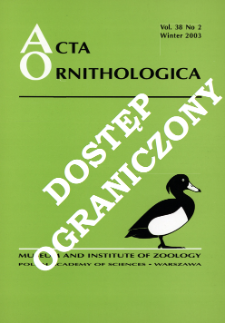- Wyszukaj w całym Repozytorium
- Piśmiennictwo i mapy
- Archeologia
- Baza Młynów
- Nauki przyrodnicze
Wyszukiwanie zaawansowane
Wyszukiwanie zaawansowane
Wyszukiwanie zaawansowane
Wyszukiwanie zaawansowane
Wyszukiwanie zaawansowane

Obiekt
Tytuł: Heavy metals, resting metabolism rates and breeding parameters in two populations of black-headed gull Larus ridibundus from the industrially polluted areas of Upper Silesia, Poland
Twórca:
Migula, Paweł ; Augustyniak, Maria ; Szymczyk, Artur ; Kowalczyk, Katarzyna
Data wydania/powstania:
Typ zasobu:
Inny tytuł:
Acta Ornithologica, vol. 35, no. 2 ; Skażenie metalami ciężkimi, metabolizm tlenowy i parametry lęgowe dwóch populacji lęgowych mewy śmieszki na obszarach zanieczyszczonych przez przemysł (Górny Śląsk) ; Black-headed gull and heavy metals
Współtwórca:
Polska Akademia Nauk. Muzeum i Instytut Zoologii
Wydawca:
Muzeum i Instytut Zoologii PAN
Miejsce wydania:
Opis:
Bibliogr. s. 169-171 ; S. [159]-172 : il. ; 27 cm ; Streszcz. pol. Nazwy taksonów także w jęz. łac.
Typ obiektu:
Abstrakt:
Black-headed Gulls breeding in the central part of the Upper Silesian Industrial Region (Katowice-Szopienice) in Southern Poland were compared with the colony from the less polluted area (Świerklaniec) situated in a distance of 23 km. Heavy metals: Cd, Pb, Zn and Cu were determined in various organs of nestlings, fledglings and mature birds as well as egg yolks. Resting metabolism rates, hatching success and eggshell thickness were used as biomarkers of environmental exposure to industrial pollutants. The clutch size (2.97 versus 3.61) and hatching success (81.5% versus 87%) were lower in the colony from the more polluted site. Relatively high metal contents in yolks indicate only a partial protection of the offspring from toxic compounds. Gulls were able to regulate body contents of essential metals Zn and Cu, but Pb and Cd accumulated rapidly in the liver, kidneys, and lungs of developing birds. Cd also accumulated in the ovaries at the similar levels as in the kidneys. Cd and Pb may have affected earlier stages of development when parents were foraged in a close vicinity of heavily polluted area and once the young gulls had reached a maturity they then foraged in distant areas. During this period they were exposed to pollutants in a similar way as the gulls from a less polluted site. There was no growth impairment identified in gulls from the more polluted area, and their resting metabolism (RMR) calculated per unit of body weight was lower, indicating that energetic costs for detoxification were not as high.
Czasopismo/Seria/cykl:
Tom:
Zeszyt:
Strona pocz.:
Strona końc.:
Szczegółowy typ zasobu:
Format:
Identyfikator zasobu:
Źródło:
MiIZ PAN, patrz sygn. czas. P.257, Vol. 35, No 2 ; MiIZ PAN, patrz sygn. czas. P.4568, Vol. 35, No 2 ; kliknij tutaj, żeby przejść
Język:
Prawa:
Prawa zastrzeżone - dostęp ograniczony
Zasady wykorzystania:
Digitalizacja:
Muzeum i Instytut Zoologii Polskiej Akademii Nauk
Lokalizacja oryginału:
Biblioteka Muzeum i Instytutu Zoologii PAN
Dofinansowane ze środków:
Program Operacyjny Innowacyjna Gospodarka, lata 2010-2014, Priorytet 2. Infrastruktura strefy B + R ; Unia Europejska. Europejski Fundusz Rozwoju Regionalnego
Dostęp:
Kolekcje, do których przypisany jest obiekt:
- Repozytorium Cyfrowe Instytutów Naukowych > Kolekcje Partnerów > Muzeum i Instytut Zoologii PAN > Czasopisma
- Repozytorium Cyfrowe Instytutów Naukowych > Kolekcje Partnerów > Muzeum i Instytut Zoologii PAN > Wydawnictwa MiIZ PAN > Acta Ornithologica
- Repozytorium Cyfrowe Instytutów Naukowych > Piśmiennictwo > Czasopisma/Artykuły
Data ostatniej modyfikacji:
4 lut 2025
Data dodania obiektu:
22 maj 2014
Liczba pobrań / odtworzeń:
154
Wszystkie dostępne wersje tego obiektu:
https://rcin.org.pl/publication/61281
Wyświetl opis w formacie RDF:
Wyświetl opis w formacie RDFa:
Wyświetl opis w formacie OAI-PMH:
Obiekty Podobne
Vīksne, Jānis (1936– )
Szulc-Olechowa, Bogumiła (1941– )
Wesołowski, Tomasz (1950– ) Głażewska, Ewa Głażewski, Lech Hejnowicz, Ewa Nawrocka, Beata Nawrocki, Przemysław Okońska, Krystyna
Luniak, Maciej (1936– )
Kuročkin, Evgenij Nikolaevič
Birkenmajer, Krzysztof (1929– )
Wesołowski, Tomasz (1950– ) Głażewska, Ewa Głażewski, Lech Nawrocka, Beata Nawrocki, Przemysław Okońska, Krystyna
Dosch, Jerald J.

 INSTYTUT ARCHEOLOGII I ETNOLOGII POLSKIEJ AKADEMII NAUK
INSTYTUT ARCHEOLOGII I ETNOLOGII POLSKIEJ AKADEMII NAUK
 INSTYTUT BADAŃ LITERACKICH POLSKIEJ AKADEMII NAUK
INSTYTUT BADAŃ LITERACKICH POLSKIEJ AKADEMII NAUK
 INSTYTUT BADAWCZY LEŚNICTWA
INSTYTUT BADAWCZY LEŚNICTWA
 INSTYTUT BIOLOGII DOŚWIADCZALNEJ IM. MARCELEGO NENCKIEGO POLSKIEJ AKADEMII NAUK
INSTYTUT BIOLOGII DOŚWIADCZALNEJ IM. MARCELEGO NENCKIEGO POLSKIEJ AKADEMII NAUK
 INSTYTUT BIOLOGII SSAKÓW POLSKIEJ AKADEMII NAUK
INSTYTUT BIOLOGII SSAKÓW POLSKIEJ AKADEMII NAUK
 INSTYTUT CHEMII FIZYCZNEJ PAN
INSTYTUT CHEMII FIZYCZNEJ PAN
 INSTYTUT CHEMII ORGANICZNEJ PAN
INSTYTUT CHEMII ORGANICZNEJ PAN
 INSTYTUT FILOZOFII I SOCJOLOGII PAN
INSTYTUT FILOZOFII I SOCJOLOGII PAN
 INSTYTUT GEOGRAFII I PRZESTRZENNEGO ZAGOSPODAROWANIA PAN
INSTYTUT GEOGRAFII I PRZESTRZENNEGO ZAGOSPODAROWANIA PAN
 INSTYTUT HISTORII im. TADEUSZA MANTEUFFLA POLSKIEJ AKADEMII NAUK
INSTYTUT HISTORII im. TADEUSZA MANTEUFFLA POLSKIEJ AKADEMII NAUK
 INSTYTUT JĘZYKA POLSKIEGO POLSKIEJ AKADEMII NAUK
INSTYTUT JĘZYKA POLSKIEGO POLSKIEJ AKADEMII NAUK
 INSTYTUT MATEMATYCZNY PAN
INSTYTUT MATEMATYCZNY PAN
 INSTYTUT MEDYCYNY DOŚWIADCZALNEJ I KLINICZNEJ IM.MIROSŁAWA MOSSAKOWSKIEGO POLSKIEJ AKADEMII NAUK
INSTYTUT MEDYCYNY DOŚWIADCZALNEJ I KLINICZNEJ IM.MIROSŁAWA MOSSAKOWSKIEGO POLSKIEJ AKADEMII NAUK
 INSTYTUT PODSTAWOWYCH PROBLEMÓW TECHNIKI PAN
INSTYTUT PODSTAWOWYCH PROBLEMÓW TECHNIKI PAN
 INSTYTUT SLAWISTYKI PAN
INSTYTUT SLAWISTYKI PAN
 SIEĆ BADAWCZA ŁUKASIEWICZ - INSTYTUT TECHNOLOGII MATERIAŁÓW ELEKTRONICZNYCH
SIEĆ BADAWCZA ŁUKASIEWICZ - INSTYTUT TECHNOLOGII MATERIAŁÓW ELEKTRONICZNYCH
 MUZEUM I INSTYTUT ZOOLOGII POLSKIEJ AKADEMII NAUK
MUZEUM I INSTYTUT ZOOLOGII POLSKIEJ AKADEMII NAUK
 INSTYTUT BADAŃ SYSTEMOWYCH PAN
INSTYTUT BADAŃ SYSTEMOWYCH PAN
 INSTYTUT BOTANIKI IM. WŁADYSŁAWA SZAFERA POLSKIEJ AKADEMII NAUK
INSTYTUT BOTANIKI IM. WŁADYSŁAWA SZAFERA POLSKIEJ AKADEMII NAUK




































